Critical Analysis of Statistical Tools in Melbourne Foodbowl Report
VerifiedAdded on 2021/06/18
|5
|1297
|14
Report
AI Summary
This individual report critically analyzes the statistical tools employed in Deloitte Access Economics' report, "The economic contribution of Melbourne's foodbowl." The analysis focuses on the presentation of key statistical information, examining quantitative variables, data sources (primarily secondary data from the Australian Bureau of Statistics), and graphical techniques like pie, column, and bar charts used for data summarization. The report highlights the use of descriptive statistics to convey information about food production, population, and economic data related to the Melbourne foodbowl. It notes the absence of inferential statistics and minimal use of averaging, with suggestions for improving information representation, such as labeling data values directly on the charts and including trends in land availability. The report concludes by emphasizing the importance of the Melbourne foodbowl, the application of descriptive statistics, and the need for more comprehensive future land use data.
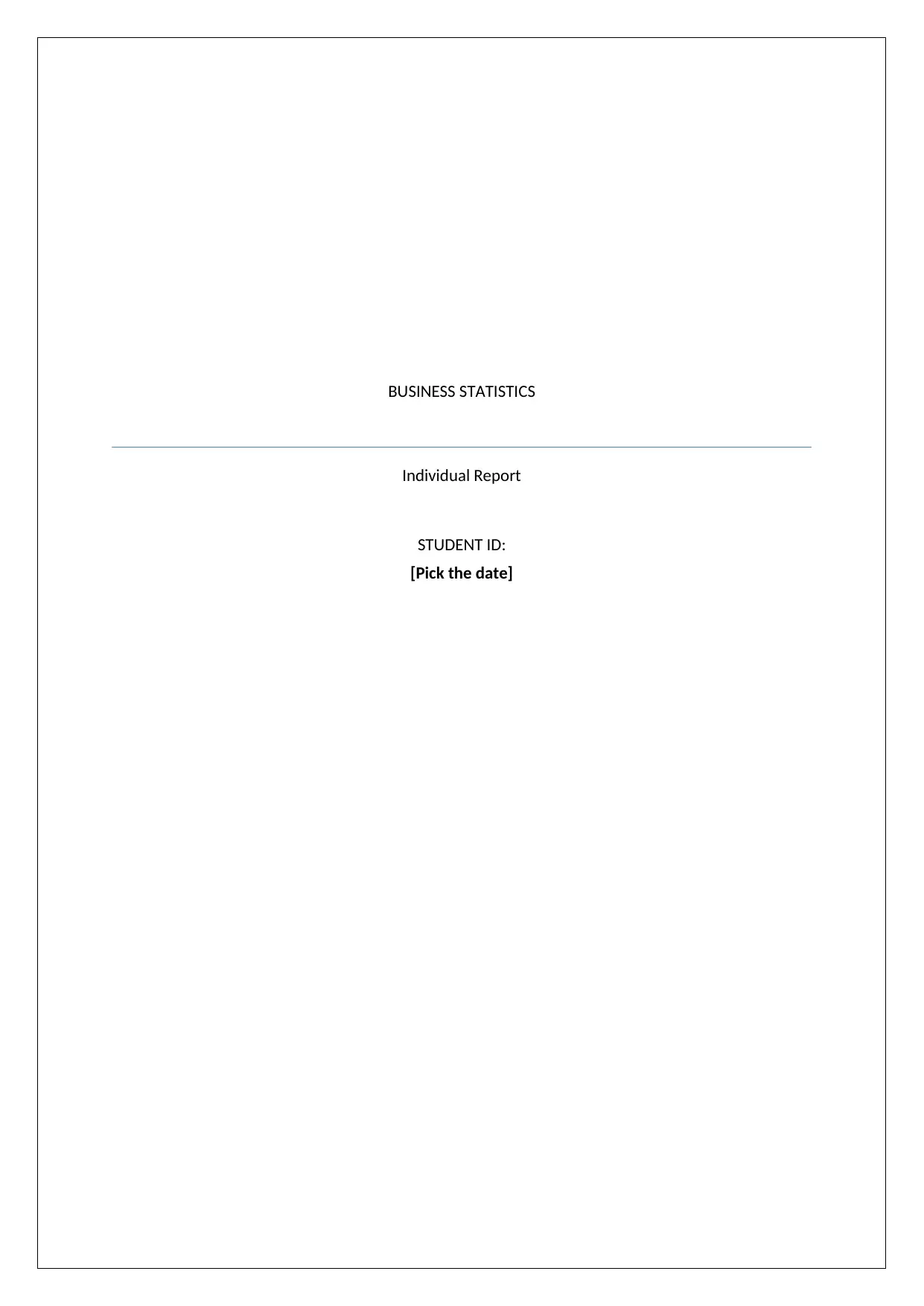
BUSINESS STATISTICS
Individual Report
STUDENT ID:
[Pick the date]
Individual Report
STUDENT ID:
[Pick the date]
Paraphrase This Document
Need a fresh take? Get an instant paraphrase of this document with our AI Paraphraser
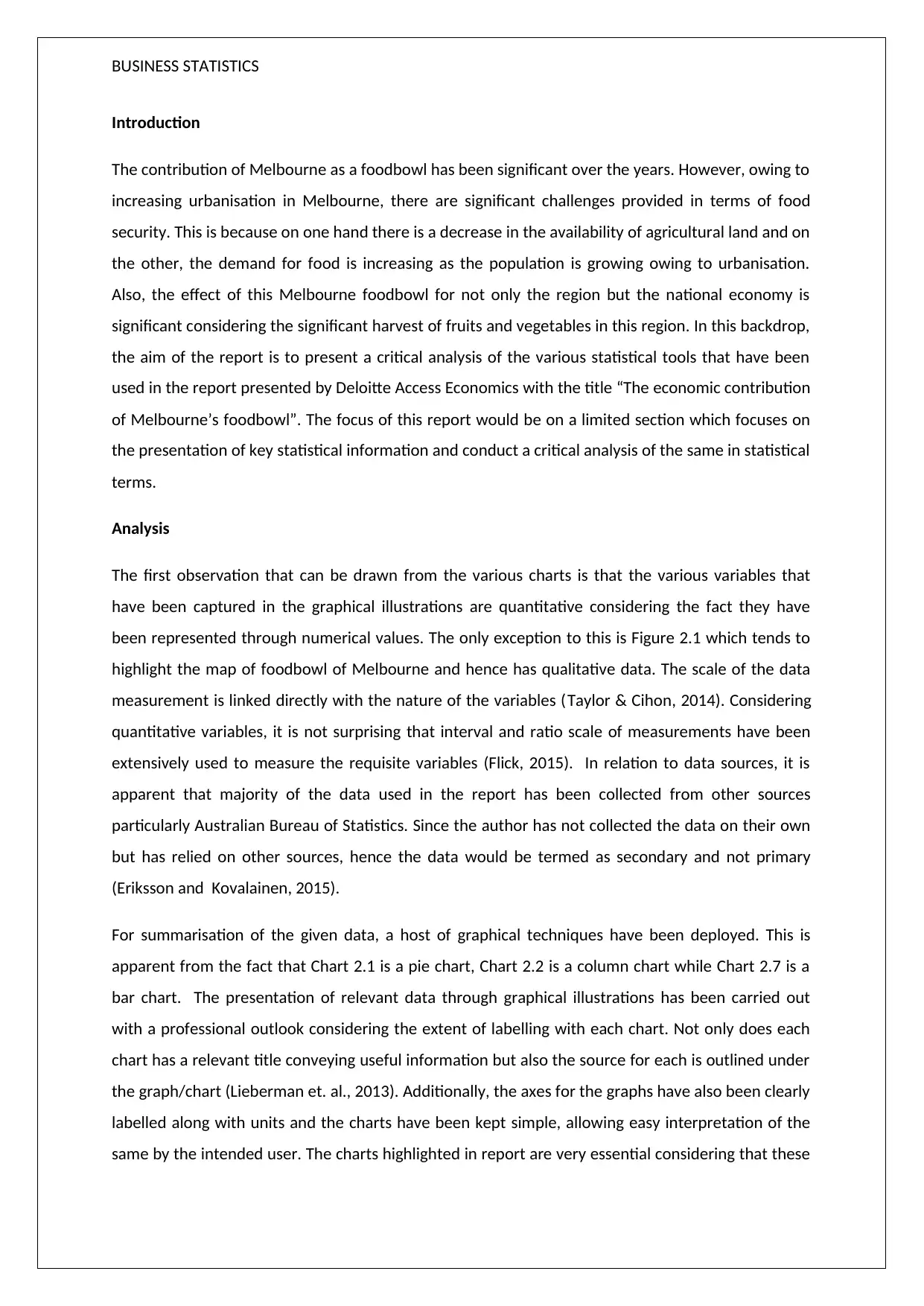
BUSINESS STATISTICS
Introduction
The contribution of Melbourne as a foodbowl has been significant over the years. However, owing to
increasing urbanisation in Melbourne, there are significant challenges provided in terms of food
security. This is because on one hand there is a decrease in the availability of agricultural land and on
the other, the demand for food is increasing as the population is growing owing to urbanisation.
Also, the effect of this Melbourne foodbowl for not only the region but the national economy is
significant considering the significant harvest of fruits and vegetables in this region. In this backdrop,
the aim of the report is to present a critical analysis of the various statistical tools that have been
used in the report presented by Deloitte Access Economics with the title “The economic contribution
of Melbourne’s foodbowl”. The focus of this report would be on a limited section which focuses on
the presentation of key statistical information and conduct a critical analysis of the same in statistical
terms.
Analysis
The first observation that can be drawn from the various charts is that the various variables that
have been captured in the graphical illustrations are quantitative considering the fact they have
been represented through numerical values. The only exception to this is Figure 2.1 which tends to
highlight the map of foodbowl of Melbourne and hence has qualitative data. The scale of the data
measurement is linked directly with the nature of the variables (Taylor & Cihon, 2014). Considering
quantitative variables, it is not surprising that interval and ratio scale of measurements have been
extensively used to measure the requisite variables (Flick, 2015). In relation to data sources, it is
apparent that majority of the data used in the report has been collected from other sources
particularly Australian Bureau of Statistics. Since the author has not collected the data on their own
but has relied on other sources, hence the data would be termed as secondary and not primary
(Eriksson and Kovalainen, 2015).
For summarisation of the given data, a host of graphical techniques have been deployed. This is
apparent from the fact that Chart 2.1 is a pie chart, Chart 2.2 is a column chart while Chart 2.7 is a
bar chart. The presentation of relevant data through graphical illustrations has been carried out
with a professional outlook considering the extent of labelling with each chart. Not only does each
chart has a relevant title conveying useful information but also the source for each is outlined under
the graph/chart (Lieberman et. al., 2013). Additionally, the axes for the graphs have also been clearly
labelled along with units and the charts have been kept simple, allowing easy interpretation of the
same by the intended user. The charts highlighted in report are very essential considering that these
Introduction
The contribution of Melbourne as a foodbowl has been significant over the years. However, owing to
increasing urbanisation in Melbourne, there are significant challenges provided in terms of food
security. This is because on one hand there is a decrease in the availability of agricultural land and on
the other, the demand for food is increasing as the population is growing owing to urbanisation.
Also, the effect of this Melbourne foodbowl for not only the region but the national economy is
significant considering the significant harvest of fruits and vegetables in this region. In this backdrop,
the aim of the report is to present a critical analysis of the various statistical tools that have been
used in the report presented by Deloitte Access Economics with the title “The economic contribution
of Melbourne’s foodbowl”. The focus of this report would be on a limited section which focuses on
the presentation of key statistical information and conduct a critical analysis of the same in statistical
terms.
Analysis
The first observation that can be drawn from the various charts is that the various variables that
have been captured in the graphical illustrations are quantitative considering the fact they have
been represented through numerical values. The only exception to this is Figure 2.1 which tends to
highlight the map of foodbowl of Melbourne and hence has qualitative data. The scale of the data
measurement is linked directly with the nature of the variables (Taylor & Cihon, 2014). Considering
quantitative variables, it is not surprising that interval and ratio scale of measurements have been
extensively used to measure the requisite variables (Flick, 2015). In relation to data sources, it is
apparent that majority of the data used in the report has been collected from other sources
particularly Australian Bureau of Statistics. Since the author has not collected the data on their own
but has relied on other sources, hence the data would be termed as secondary and not primary
(Eriksson and Kovalainen, 2015).
For summarisation of the given data, a host of graphical techniques have been deployed. This is
apparent from the fact that Chart 2.1 is a pie chart, Chart 2.2 is a column chart while Chart 2.7 is a
bar chart. The presentation of relevant data through graphical illustrations has been carried out
with a professional outlook considering the extent of labelling with each chart. Not only does each
chart has a relevant title conveying useful information but also the source for each is outlined under
the graph/chart (Lieberman et. al., 2013). Additionally, the axes for the graphs have also been clearly
labelled along with units and the charts have been kept simple, allowing easy interpretation of the
same by the intended user. The charts highlighted in report are very essential considering that these
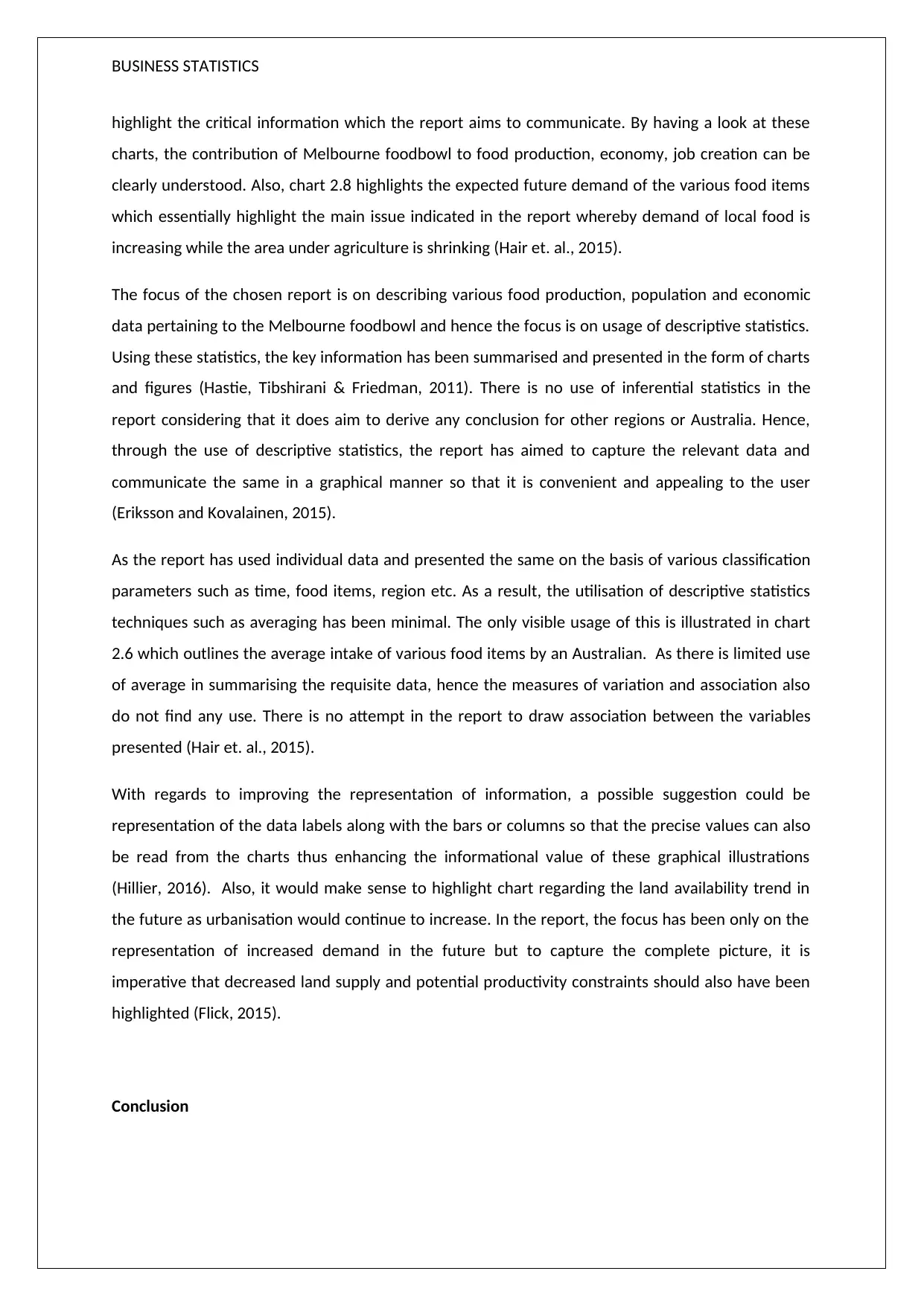
BUSINESS STATISTICS
highlight the critical information which the report aims to communicate. By having a look at these
charts, the contribution of Melbourne foodbowl to food production, economy, job creation can be
clearly understood. Also, chart 2.8 highlights the expected future demand of the various food items
which essentially highlight the main issue indicated in the report whereby demand of local food is
increasing while the area under agriculture is shrinking (Hair et. al., 2015).
The focus of the chosen report is on describing various food production, population and economic
data pertaining to the Melbourne foodbowl and hence the focus is on usage of descriptive statistics.
Using these statistics, the key information has been summarised and presented in the form of charts
and figures (Hastie, Tibshirani & Friedman, 2011). There is no use of inferential statistics in the
report considering that it does aim to derive any conclusion for other regions or Australia. Hence,
through the use of descriptive statistics, the report has aimed to capture the relevant data and
communicate the same in a graphical manner so that it is convenient and appealing to the user
(Eriksson and Kovalainen, 2015).
As the report has used individual data and presented the same on the basis of various classification
parameters such as time, food items, region etc. As a result, the utilisation of descriptive statistics
techniques such as averaging has been minimal. The only visible usage of this is illustrated in chart
2.6 which outlines the average intake of various food items by an Australian. As there is limited use
of average in summarising the requisite data, hence the measures of variation and association also
do not find any use. There is no attempt in the report to draw association between the variables
presented (Hair et. al., 2015).
With regards to improving the representation of information, a possible suggestion could be
representation of the data labels along with the bars or columns so that the precise values can also
be read from the charts thus enhancing the informational value of these graphical illustrations
(Hillier, 2016). Also, it would make sense to highlight chart regarding the land availability trend in
the future as urbanisation would continue to increase. In the report, the focus has been only on the
representation of increased demand in the future but to capture the complete picture, it is
imperative that decreased land supply and potential productivity constraints should also have been
highlighted (Flick, 2015).
Conclusion
highlight the critical information which the report aims to communicate. By having a look at these
charts, the contribution of Melbourne foodbowl to food production, economy, job creation can be
clearly understood. Also, chart 2.8 highlights the expected future demand of the various food items
which essentially highlight the main issue indicated in the report whereby demand of local food is
increasing while the area under agriculture is shrinking (Hair et. al., 2015).
The focus of the chosen report is on describing various food production, population and economic
data pertaining to the Melbourne foodbowl and hence the focus is on usage of descriptive statistics.
Using these statistics, the key information has been summarised and presented in the form of charts
and figures (Hastie, Tibshirani & Friedman, 2011). There is no use of inferential statistics in the
report considering that it does aim to derive any conclusion for other regions or Australia. Hence,
through the use of descriptive statistics, the report has aimed to capture the relevant data and
communicate the same in a graphical manner so that it is convenient and appealing to the user
(Eriksson and Kovalainen, 2015).
As the report has used individual data and presented the same on the basis of various classification
parameters such as time, food items, region etc. As a result, the utilisation of descriptive statistics
techniques such as averaging has been minimal. The only visible usage of this is illustrated in chart
2.6 which outlines the average intake of various food items by an Australian. As there is limited use
of average in summarising the requisite data, hence the measures of variation and association also
do not find any use. There is no attempt in the report to draw association between the variables
presented (Hair et. al., 2015).
With regards to improving the representation of information, a possible suggestion could be
representation of the data labels along with the bars or columns so that the precise values can also
be read from the charts thus enhancing the informational value of these graphical illustrations
(Hillier, 2016). Also, it would make sense to highlight chart regarding the land availability trend in
the future as urbanisation would continue to increase. In the report, the focus has been only on the
representation of increased demand in the future but to capture the complete picture, it is
imperative that decreased land supply and potential productivity constraints should also have been
highlighted (Flick, 2015).
Conclusion
⊘ This is a preview!⊘
Do you want full access?
Subscribe today to unlock all pages.

Trusted by 1+ million students worldwide
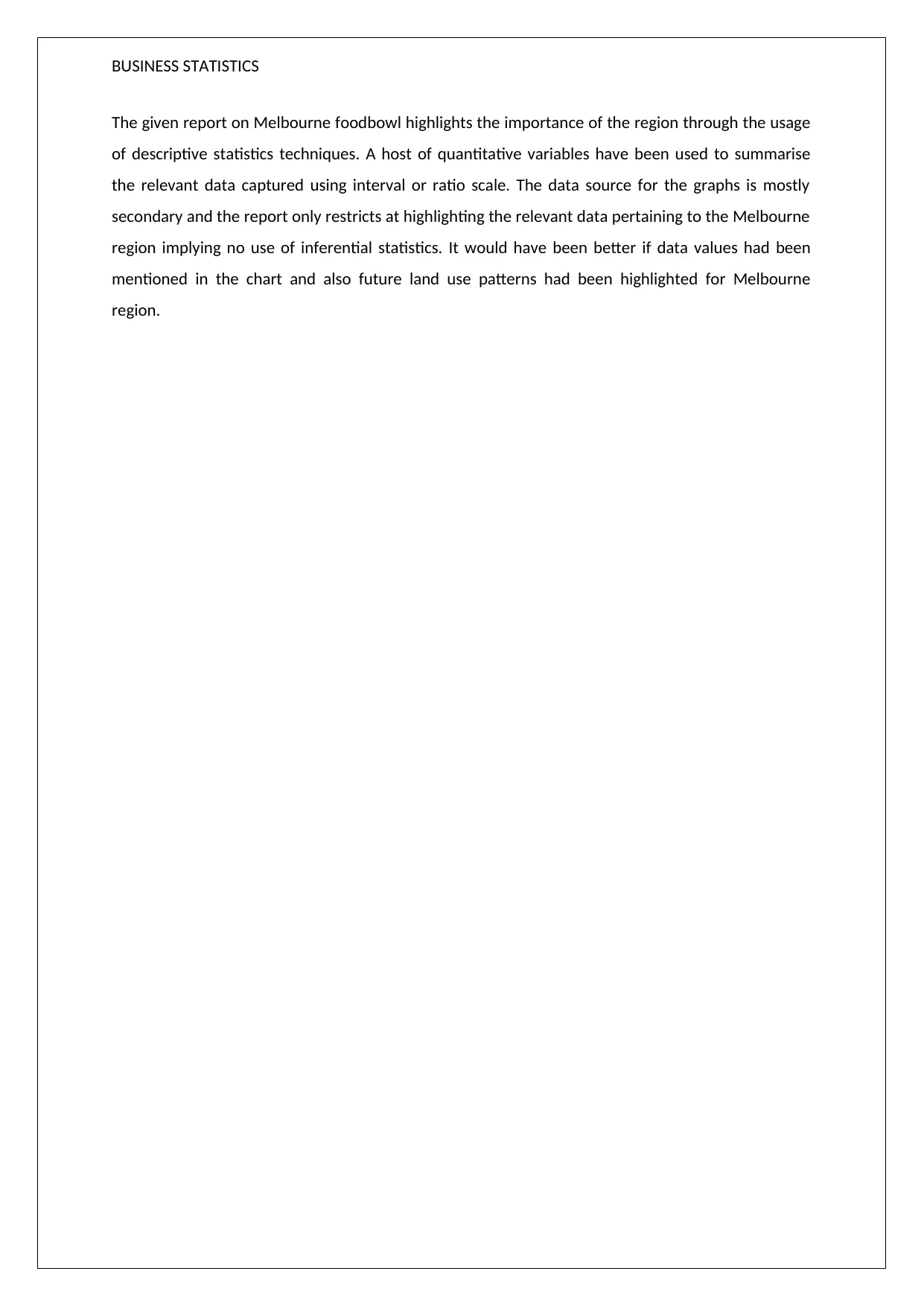
BUSINESS STATISTICS
The given report on Melbourne foodbowl highlights the importance of the region through the usage
of descriptive statistics techniques. A host of quantitative variables have been used to summarise
the relevant data captured using interval or ratio scale. The data source for the graphs is mostly
secondary and the report only restricts at highlighting the relevant data pertaining to the Melbourne
region implying no use of inferential statistics. It would have been better if data values had been
mentioned in the chart and also future land use patterns had been highlighted for Melbourne
region.
The given report on Melbourne foodbowl highlights the importance of the region through the usage
of descriptive statistics techniques. A host of quantitative variables have been used to summarise
the relevant data captured using interval or ratio scale. The data source for the graphs is mostly
secondary and the report only restricts at highlighting the relevant data pertaining to the Melbourne
region implying no use of inferential statistics. It would have been better if data values had been
mentioned in the chart and also future land use patterns had been highlighted for Melbourne
region.
Paraphrase This Document
Need a fresh take? Get an instant paraphrase of this document with our AI Paraphraser
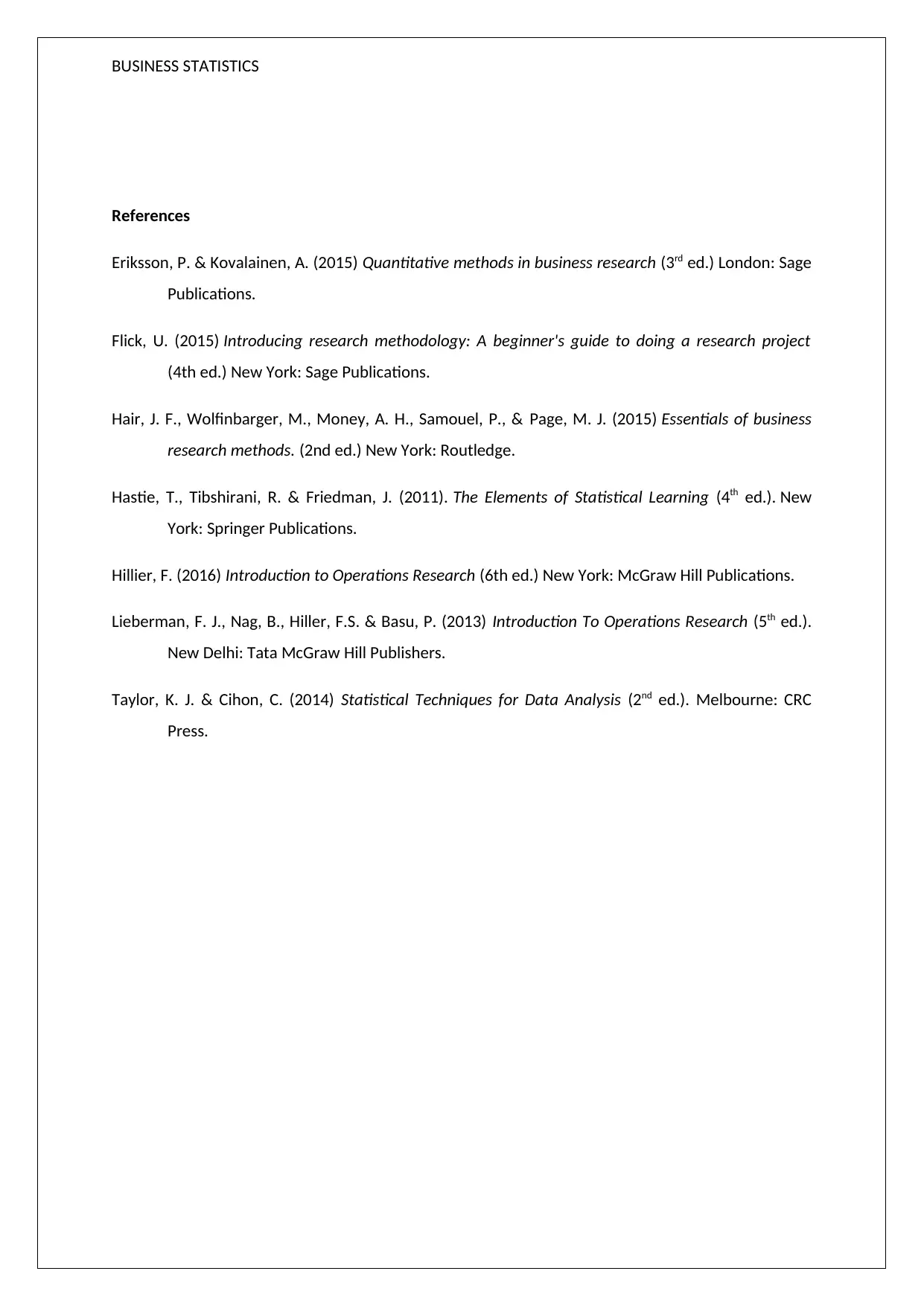
BUSINESS STATISTICS
References
Eriksson, P. & Kovalainen, A. (2015) Quantitative methods in business research (3rd ed.) London: Sage
Publications.
Flick, U. (2015) Introducing research methodology: A beginner's guide to doing a research project
(4th ed.) New York: Sage Publications.
Hair, J. F., Wolfinbarger, M., Money, A. H., Samouel, P., & Page, M. J. (2015) Essentials of business
research methods. (2nd ed.) New York: Routledge.
Hastie, T., Tibshirani, R. & Friedman, J. (2011). The Elements of Statistical Learning (4th ed.). New
York: Springer Publications.
Hillier, F. (2016) Introduction to Operations Research (6th ed.) New York: McGraw Hill Publications.
Lieberman, F. J., Nag, B., Hiller, F.S. & Basu, P. (2013) Introduction To Operations Research (5th ed.).
New Delhi: Tata McGraw Hill Publishers.
Taylor, K. J. & Cihon, C. (2014) Statistical Techniques for Data Analysis (2nd ed.). Melbourne: CRC
Press.
References
Eriksson, P. & Kovalainen, A. (2015) Quantitative methods in business research (3rd ed.) London: Sage
Publications.
Flick, U. (2015) Introducing research methodology: A beginner's guide to doing a research project
(4th ed.) New York: Sage Publications.
Hair, J. F., Wolfinbarger, M., Money, A. H., Samouel, P., & Page, M. J. (2015) Essentials of business
research methods. (2nd ed.) New York: Routledge.
Hastie, T., Tibshirani, R. & Friedman, J. (2011). The Elements of Statistical Learning (4th ed.). New
York: Springer Publications.
Hillier, F. (2016) Introduction to Operations Research (6th ed.) New York: McGraw Hill Publications.
Lieberman, F. J., Nag, B., Hiller, F.S. & Basu, P. (2013) Introduction To Operations Research (5th ed.).
New Delhi: Tata McGraw Hill Publishers.
Taylor, K. J. & Cihon, C. (2014) Statistical Techniques for Data Analysis (2nd ed.). Melbourne: CRC
Press.
1 out of 5
Related Documents
Your All-in-One AI-Powered Toolkit for Academic Success.
+13062052269
info@desklib.com
Available 24*7 on WhatsApp / Email
![[object Object]](/_next/static/media/star-bottom.7253800d.svg)
Unlock your academic potential
Copyright © 2020–2025 A2Z Services. All Rights Reserved. Developed and managed by ZUCOL.





